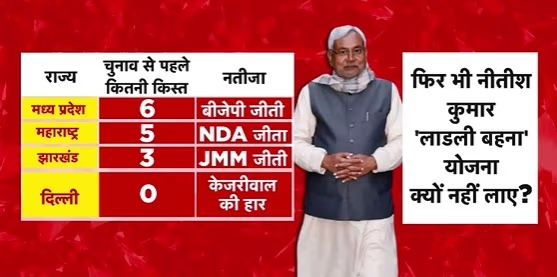Following the presentation of the state's annual budget in the Bihar Assembly, the pressing question remains: Is Nitish Kumar devising a strategy to sway the female voter bloc, potentially altering the political landscape? Election strategy suggests that aligning with women voters requires early promises.
If monthly payments start arriving in women's accounts, the assurance of electoral victory increases. This is evident in Maharashtra and Madhya Pradesh, where multiple installments reached women's bank accounts, securing victories for the governments. However, a similar program in Delhi under Kejriwal did not succeed due to lack of direct cash distribution.
Scene 1 in the Bihar Assembly: Deputy Chief Minister Samrat Chaudhary, holding the finance ministry position, reads the budget speech. Meanwhile, Chief Minister Nitish Kumar gestures towards former Deputy Chief Minister Tejashwi Yadav, supposedly seeking his response before cameras turned away, leaving only Tejashwi Yadav's smiling acknowledgment visible.
Former Deputy Chief Minister Tejashwi Yadav revealed that the gestures included asking what Yadav was chewing during the session. Yadav jokingly mentioned it wasn't anything to worry about, since he had just returned from lunch.
Scene 2 in the Bihar Assembly: As Samrat Chaudhary concludes his budget speech, Nitish Kumar notably stands up, pats Chaudhary's back, and embraces him, sparking applause in the assembly. Is this a celebration of the government's final comprehensive budget, or is there a political narrative at play?
Deputy CM Samrat Chaudhary describes Nitish Kumar as a fatherly figure, expressing gratitude for his blessings. Tejashwi Yadav adds that Nitish is in the habit of guiding and supporting new members, a trait noticed by all.
After the speech, Nitish Kumar questions Tejashwi's food choices through gestures, then embraces the BJP-aligned Deputy CM Chaudhary. Could these non-verbal interactions carry political undertones? The speculation arises amid the narrative surrounding Nitish's political maneuvers in Bihar with elections looming in eight months, with no major announcements for women voters yet.

Source: aajtak
The importance of the female vote is evident from the success of the Ladli Behen plan in Madhya Pradesh, which contributed to the BJP's huge victory by transferring six installments ahead of elections. Similarly, Maharashtra's triumph was secured by delivering five installments prior to elections.
In contrast, Kejriwal in Delhi failed to secure women's votes due to an absence of deliverable promises, raising questions about why Nitish Kumar's government has not proposed a Ladli Behen-like plan?
Announced initiatives for women in the Bihar budget include:
Dedicated spaces for women in vending zones in all major cities in Bihar.
Establishment of a women's bazaar in Patna.
Introduction of Pink Toilets and Pink Buses for women in all cities.
Implementing 33% reservation for women in the roles of drivers, conductors, and depot maintenance staff at Bihar Roadways bus services.
Cash grants for women purchasing commercial e-rickshaws and two-wheelers.
Accommodation support for policewomen near their stations.
Setting up hostels for working women in major cities.
Samrat Chaudhary also mentioned that Nitish Kumar allocated 46,000 crores to support groups, but Tejashwi Yadav criticizes Bihar Transport's inefficiencies, dismissing these announcements as mere rhetoric.
In a state like Bihar, where women voters have consistently outvoted men in three consecutive elections, it raises queries why Nitish Kumar has not introduced a women-centric plan akin to Ladli Behen.
Reflecting on past caste census eras, where Tejashwi-Congress allied with Nitish only for him to part ways later, sharing credits for the census. Could Nitish be waiting for a strategic moment to announce any women-focused cash distribution scheme?
Trust of Women Voters in Nitish:
Nitish Kumar's recent Women's Dialogue Tour further underscores this trust. However, he omitted cash distribution plans for women—the most significant electoral strategy—from his last pre-election budget. Does this suggest that more women are now inclined towards the BJP than JD(U)?
According to the Election Commission, in 2010, 53% of men voted in Bihar, compared to 54.5% women. Nitish's party secured 115 assembly seats, just 7 short of a majority.
2015 Assembly Elections:
Women also led in voting turnout in 2015, with 51.1% of men voting versus 60.4% women, lending 9% more votes from women despite JD(U) separated from BJP and aligning with RJD. Nitish's party won 71 seats, ranking second.
2020 Assembly Elections:
The 2020 election saw 54.6% men voting, while women had a turnout of 59.7%. Nitish's party fell to third place, winning only 43 assembly seats, the JD(U)'s weakest NDA performance, despite fielding 22 women candidates, out of which 6 were elected. In contrast, the BJP fielded 13 women and secured victories in 8 seats.
The data suggests a stronger trust of women voters gravitating towards the BJP, potentially explaining Nitish's budget absence of a winning strategy like Ladli Behen. Anticipating future political scenarios, Nitish may be waiting for the right moment to unveil such programs.




